HOW TO: Configure basic networking on a VMware vSphere Hypervisor 5.1 (ESXi 5.1) Host Server
EE Fellow, MVE, Expert of the Year 2021,2017-11, Scribe 2016-2012, Author of the Year 2018-6,2013-2012 VMware vExpert Pro, vExpert 2022-2011
Published:
Browse All Articles > HOW TO: Configure basic networking on a VMware vSphere Hypervisor 5.1 (ESXi 5.1) Host Server
In my previous VMware Articles, most featured Intermediate VMware Topics. My next series of articles will concentrate on topics for the VMware Novice; this is the thirteenth article in this series.
If you would like to read the other articles in this series, they are listed here for your convenience.
During this series of articles VMware released VMware vSphere 5.5 and VMware vSphere Hypervisor ESXi 5.5. These articles are also applicable to VMware vSphere Hypervisor ESXi 5.x and 5.5. For consistency, I have used VMware vSphere Hypervisor ESXi 5.1 throughout this series.
In this series of basic VMware articles for the Novice, I'll be showing you the basic VMware skills required to install, configure and deploy virtual machines using VMware's FREE VMware vSphere Hypervisor (ESXi).
In this tutorial article, we will introduce you to virtual switches, commonly referred to as vSwitch, at the end of this tutorial, you will be able to create new a vSwitch, and add physical network interfaces to existing vSwitch, and connect a virtual machine to a new virtual machine network portgroup..
Connect to the VMware vSphere Hypervisor 5.1 (ESXi 5.1) using the vSphere Client, see my Experts Exchange article - Part 2: HOW TO: Connect to the VMware vSphere Hypervisor 5.1 (ESXi 5.1) using the vSphere Client
![network1.jpg]()
This section shows the number of installed network interfaces in the host server, they are labelled vmnic(x), where x represents a number. This section shows the vendor information for the network interface, speed and duplex settings, MAC Address, current vSwitch, and Observed IP Range - this last value is the IP Address range which has been detected on the network interface, this depends on the amount of traffic present on this network which this physical network interface is connected to.
In the screenshot below of a different server, it can clearly be seen, that the physical host server has twelve network interfaces lalled from vmnic0 to vmnic11, and they are distributed over two different models of network interface.
e.g.
vmnic0 , vmnic1, vmnic2, vmnic3 - Broadcom Corporation NetXtreme BCM5720 Gigabit Ethernet
vmnic4, vmnic5, vmnic6,vmnic7,vmnic8,vmnic9,vmnic10, vmnic11 - Broadcom Corporation NetXtreme BCM5719 Gigabit Ethernet
vmnic0 , vmnic1, vmnic2, vmnic3 are the on-board motherboard network interfaces in a Dell R720, vmnic4 to vmnic11 are two additional quad port network interfaces plugged into the PCI-e motherboard bus. To create a redundant network link and reduce a single point of failure, you can see in the screenshot below, physical network interfaces ports have been selected from different physical network interfaces for the vSwitch.
![network2.jpg]()
select the Configuration Tab, followed by Networking.
![network3.jpg]() The ESXi default installation creates a single vSwitch0, with the physical network interface uplink vmnic0, a Management Network VMKernel Portgroup, and VM Network Virtual Machine Portgroup.
The ESXi default installation creates a single vSwitch0, with the physical network interface uplink vmnic0, a Management Network VMKernel Portgroup, and VM Network Virtual Machine Portgroup.
To create redundancy for vSwitch0, and avoid a single point of failure, we will add a new physical network interface vmnic1, to the vSwitch1 as follows.
Select Properties of the vSwitch0
![network4.jpg]()
Select Network Adapters
![network5.jpg]() Select Add
Select Add
![network6.jpg]() Select vmnic1, followed by Next, Finish and Close the dialogue.
Select vmnic1, followed by Next, Finish and Close the dialogue.
![network7.jpg]() vSwitch0 now has two physical network interfaces added.
vSwitch0 now has two physical network interfaces added.
![network8.jpg]()
Select Configuration, Networking followed by Add Networking (far right)
![network9.jpg]()
Select Virtual Machine, as we want to create a new vSwitch, for Virtual Machine networking, followed by next.
![network10.jpg]() Select at least two physical network interfaces, to create a redundant vSwitch, and reduce the single point of failure, followed by Next
Select at least two physical network interfaces, to create a redundant vSwitch, and reduce the single point of failure, followed by Next
![network11.jpg]() Enter a network label, I've used the Network Label - Production LAN - this will be used to select this virtual machine network, in the VM Network Interface settings later, followed by Next, and Finish.
Enter a network label, I've used the Network Label - Production LAN - this will be used to select this virtual machine network, in the VM Network Interface settings later, followed by Next, and Finish.
![network12.jpg]() This is how networking will look, after the creation of vSwitch1.
This is how networking will look, after the creation of vSwitch1.
![network13.jpg]() The ESXi host now has two vSwitch, vSwitch0 and vSwitch1.
The ESXi host now has two vSwitch, vSwitch0 and vSwitch1.
Right Click the virtual machine, and select Edit Settings
![network14.jpg]()
Select Network adapter 1 in the virtual machine, and change the Network Connection, to Production LAN, followed by OK.
![network15.jpg]()
Checking Networking, will show the change, and the virtual machine is using a different vSwitch, vSwitch1.
![network16.jpg]() Congratulations, you have successfully added a network interface to a vSwitch, created a new vSwitch and virtual machine network portgroup, and connected a Virtual Machine to this new virtual machine network portgroup.
Congratulations, you have successfully added a network interface to a vSwitch, created a new vSwitch and virtual machine network portgroup, and connected a Virtual Machine to this new virtual machine network portgroup.
****************************************************************************
Thank you for reading my article, please leave valuable feedback. If you liked my VMware article and would like to see more Articles from me, please click the Yes button near the: Was this article helpful? at the bottom of this article just below and to the right of this information. Thank You. Do not forget if you have a question about this article or another VMware, Virtualisation, Windows Server 2012 question, why not post a Question for me and the other Experts Exchange Experts in the VMware, Virtualisation, Windows 2008, Windows 2012 Zones. I look forward to hearing from you. - Andy :- twitter @einsteinagogo
****************************************************************************
If you would like to read the other articles in this series, they are listed here for your convenience.
During this series of articles VMware released VMware vSphere 5.5 and VMware vSphere Hypervisor ESXi 5.5. These articles are also applicable to VMware vSphere Hypervisor ESXi 5.x and 5.5. For consistency, I have used VMware vSphere Hypervisor ESXi 5.1 throughout this series.
In this series of basic VMware articles for the Novice, I'll be showing you the basic VMware skills required to install, configure and deploy virtual machines using VMware's FREE VMware vSphere Hypervisor (ESXi).
In this tutorial article, we will introduce you to virtual switches, commonly referred to as vSwitch, at the end of this tutorial, you will be able to create new a vSwitch, and add physical network interfaces to existing vSwitch, and connect a virtual machine to a new virtual machine network portgroup..
Connect to the VMware vSphere Hypervisor 5.1 (ESXi 5.1) using the vSphere Client, see my Experts Exchange article - Part 2: HOW TO: Connect to the VMware vSphere Hypervisor 5.1 (ESXi 5.1) using the vSphere Client
1. Viewing the physical adaptors in the Host Server.
Before we start creating virtual switches (vSwitch) on the host server, we need to understand physical network interfaces (nics). Select the host server in the vSphere Client, select the Configuration Tab, followed by Network Adapters.
This section shows the number of installed network interfaces in the host server, they are labelled vmnic(x), where x represents a number. This section shows the vendor information for the network interface, speed and duplex settings, MAC Address, current vSwitch, and Observed IP Range - this last value is the IP Address range which has been detected on the network interface, this depends on the amount of traffic present on this network which this physical network interface is connected to.
In the screenshot below of a different server, it can clearly be seen, that the physical host server has twelve network interfaces lalled from vmnic0 to vmnic11, and they are distributed over two different models of network interface.
e.g.
vmnic0 , vmnic1, vmnic2, vmnic3 - Broadcom Corporation NetXtreme BCM5720 Gigabit Ethernet
vmnic4, vmnic5, vmnic6,vmnic7,vmnic8,vmnic
vmnic0 , vmnic1, vmnic2, vmnic3 are the on-board motherboard network interfaces in a Dell R720, vmnic4 to vmnic11 are two additional quad port network interfaces plugged into the PCI-e motherboard bus. To create a redundant network link and reduce a single point of failure, you can see in the screenshot below, physical network interfaces ports have been selected from different physical network interfaces for the vSwitch.

2. Select Networking in the Host Server
select the Configuration Tab, followed by Networking.
 The ESXi default installation creates a single vSwitch0, with the physical network interface uplink vmnic0, a Management Network VMKernel Portgroup, and VM Network Virtual Machine Portgroup.
The ESXi default installation creates a single vSwitch0, with the physical network interface uplink vmnic0, a Management Network VMKernel Portgroup, and VM Network Virtual Machine Portgroup.
To create redundancy for vSwitch0, and avoid a single point of failure, we will add a new physical network interface vmnic1, to the vSwitch1 as follows.
3. Add a network interface (vmnic1) to vSwitch0
Select Properties of the vSwitch0

Select Network Adapters
 Select Add
Select Add
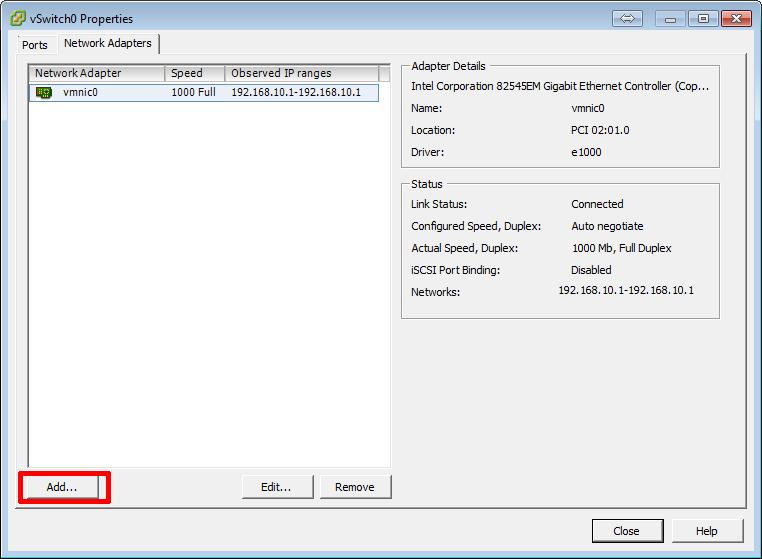 Select vmnic1, followed by Next, Finish and Close the dialogue.
Select vmnic1, followed by Next, Finish and Close the dialogue.
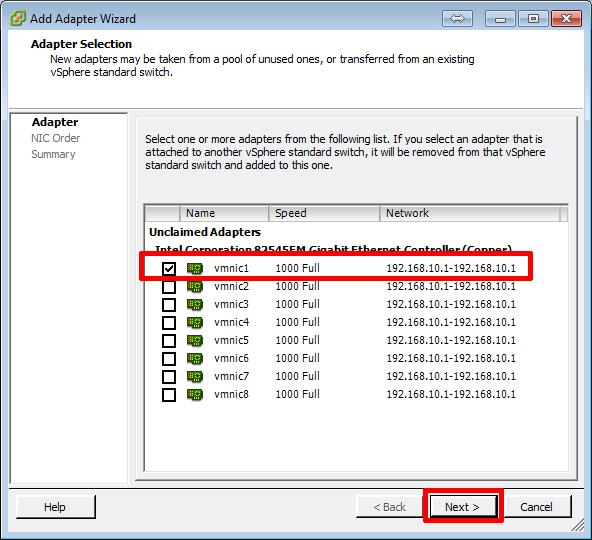 vSwitch0 now has two physical network interfaces added.
vSwitch0 now has two physical network interfaces added.

4. Creating a new vSwitch
Select Configuration, Networking followed by Add Networking (far right)

Select Virtual Machine, as we want to create a new vSwitch, for Virtual Machine networking, followed by next.
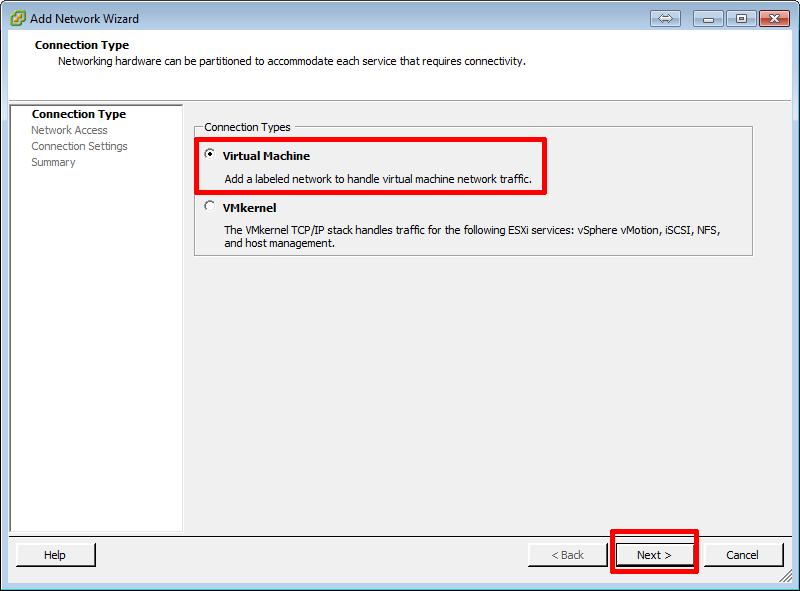 Select at least two physical network interfaces, to create a redundant vSwitch, and reduce the single point of failure, followed by Next
Select at least two physical network interfaces, to create a redundant vSwitch, and reduce the single point of failure, followed by Next
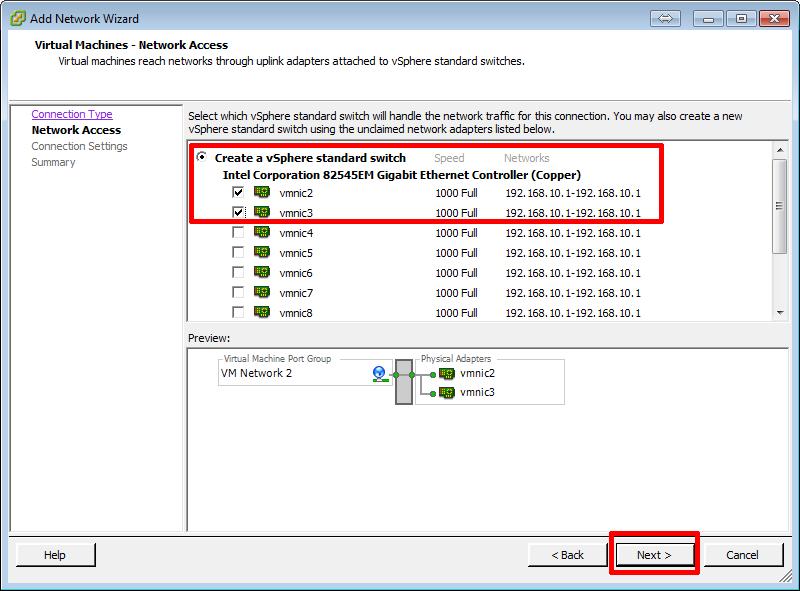 Enter a network label, I've used the Network Label - Production LAN - this will be used to select this virtual machine network, in the VM Network Interface settings later, followed by Next, and Finish.
Enter a network label, I've used the Network Label - Production LAN - this will be used to select this virtual machine network, in the VM Network Interface settings later, followed by Next, and Finish.
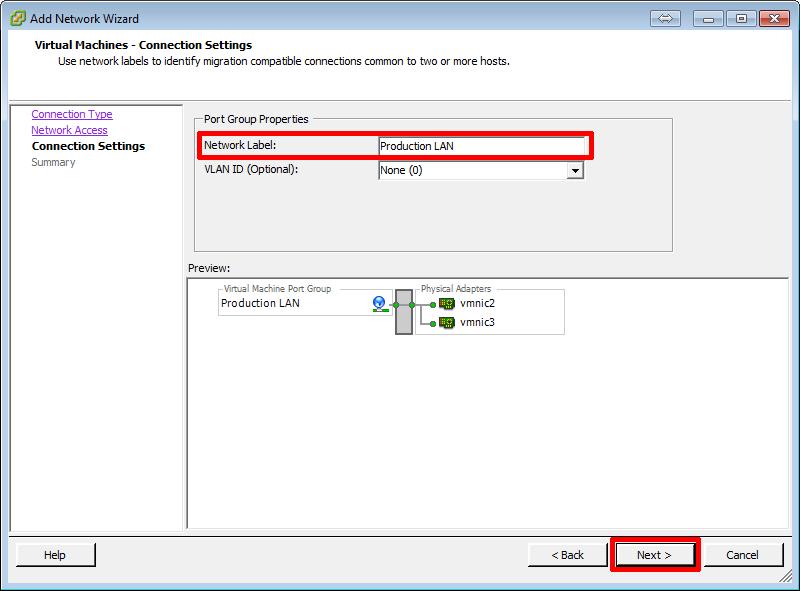 This is how networking will look, after the creation of vSwitch1.
This is how networking will look, after the creation of vSwitch1.
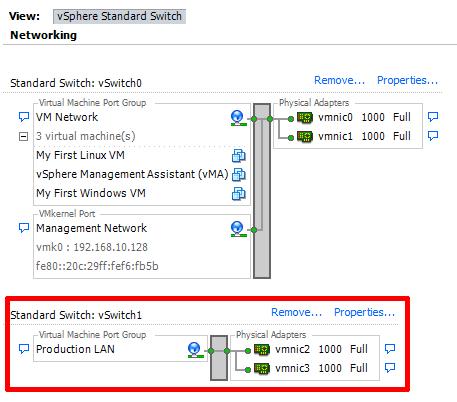 The ESXi host now has two vSwitch, vSwitch0 and vSwitch1.
The ESXi host now has two vSwitch, vSwitch0 and vSwitch1.
5. Assigning a Virtual Machine Portgroup to a Virtual Machine
Right Click the virtual machine, and select Edit Settings

Select Network adapter 1 in the virtual machine, and change the Network Connection, to Production LAN, followed by OK.
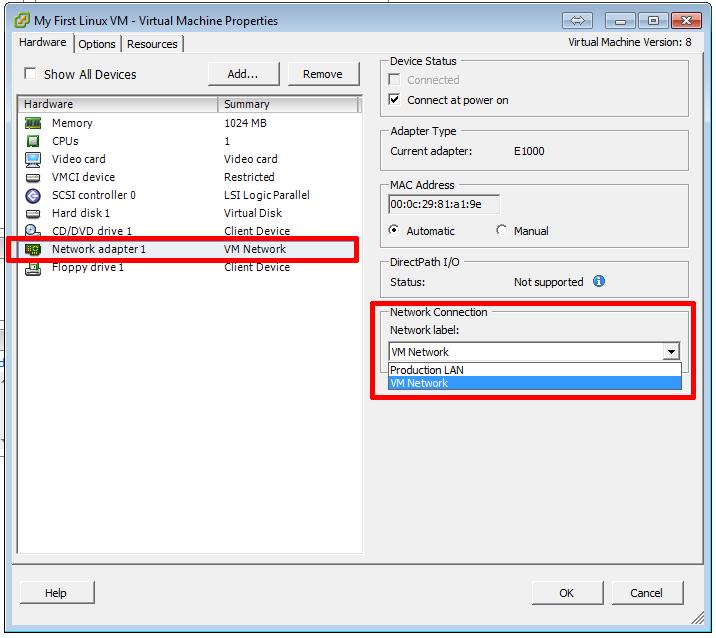
Checking Networking, will show the change, and the virtual machine is using a different vSwitch, vSwitch1.
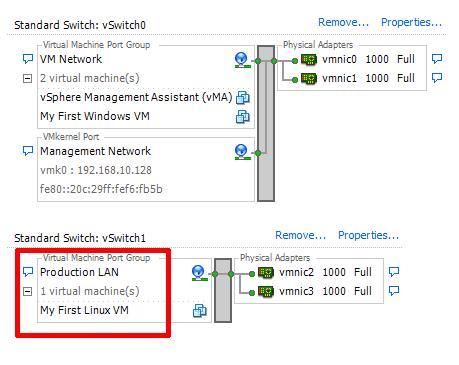 Congratulations, you have successfully added a network interface to a vSwitch, created a new vSwitch and virtual machine network portgroup, and connected a Virtual Machine to this new virtual machine network portgroup.
Congratulations, you have successfully added a network interface to a vSwitch, created a new vSwitch and virtual machine network portgroup, and connected a Virtual Machine to this new virtual machine network portgroup.
**************************
Thank you for reading my article, please leave valuable feedback. If you liked my VMware article and would like to see more Articles from me, please click the Yes button near the: Was this article helpful? at the bottom of this article just below and to the right of this information. Thank You. Do not forget if you have a question about this article or another VMware, Virtualisation, Windows Server 2012 question, why not post a Question for me and the other Experts Exchange Experts in the VMware, Virtualisation, Windows 2008, Windows 2012 Zones. I look forward to hearing from you. - Andy :- twitter @einsteinagogo
**************************
Have a question about something in this article? You can receive help directly from the article author. Sign up for a free trial to get started.


Comments (4)
Author
Commented:Thanks for your comments.
This content, has been written by me from scratch, it's my original work, it does not exist anywhere else on the Internet in this form. These are my own screenshots, servers that they have been generated from.
Please could you let me know where you think this article has published before other than my brain!
Regards
Andy
Author
Commented:I feel terribly insulted that you believe the Article I have written for EE, has been plagiarised.
Please post the URL to the blog, that you think this article is from.
It's not on my blog. this is original written content especially for EE. Hence no source reference!
If you can find any of these screenshots on the Internet please let me know, they were generated for EE, and DO NOT EXIST on the INTERNET.
I await a link to the blog you think they are from...
Andrew
Commented:
Thanks a lot Andrew for this beautiful tutorial .
JJ
Author
Commented:Andrew